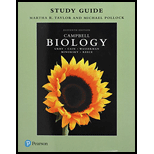
Concept explainers
a.
To define: Cytology
Introduction: Cell is a membrane bound unit that is present in all living beings and constitutes the basic unit of life. It contains different organelles to carry out different functions. Some cells are specific to their functions.
a.
Explanation of Solution
The branch of biology that deals with the study of cell and the cellular organelles are called as cytology. Cytology is the field that is concerned with the
b.
To explain: The way in which the cell biologists use a Transmission Electron Microscope (TEM) to study.
Introduction: Cells are fundamental unit of life. Some cells are macroscopic and some cells are microscopic. Cells show different shapes and sizes. Cells work together to perform common functions. Cells consists of different organelles that have different shapes and sizes and perform specialized functions.
b.
Explanation of Solution
A Transmission Electron Microscope (TEM) directs an electron beam through a thin-cut section of the specimen. A two-dimensional image of the specimen is focused either onto a screen or onto a photographic film. A TEM allows the cell biologist to visualize the details of the specimen’s internal structures. In TEM, the specimen magnifies up to 50,000X.
c.
To explain: What does a scanning electron microscope (SEM) shows the best.
Introduction: Unicellular organisms are raised from single cell, but multi-cellular organisms are raised from many cells. Microscopy is the use of microscope to view the small-scale structures. It has an important role in anatomic investigation.
c.
Explanation of Solution
The SEM is best used to see the three-dimensional surface structure of a specimen. A SEM is a type of electron microscope that produces images of a sample by scanning the surface with a focused beam of electrons.
d.
To explain: The advantages of light microscope to have over both TEM and SEM.
Introduction: The light microscopy stains help in visualizing the cell components by binding to specific cell components and influencing the light beam that passes through them. In contrary, in electron microscopy, stains bind differently to cell components and help in generating images by influencing the beam of electrons that passes through the specimen.
d.
Explanation of Solution
Microscopy is the use of microscope to see an object that cannot be seen by the naked eye. Light microscopy uses the light to view the specimen, but in electron microscopy, a beam of electron is used to view the specimen. Light microscope is to study the living cells and the TEM and SEM is to study the magnified view of the cell. The light microscope shows fewer artifacts than TEM and SEM.
Want to see more full solutions like this?
Chapter 6 Solutions
Study Guide for Campbell Biology
- Outline the negative feedback loop that allows us to maintain a healthy water concentration in our blood. You may use diagram if you wisharrow_forwardGive examples of fat soluble and non-fat soluble hormonesarrow_forwardJust click view full document and register so you can see the whole document. how do i access this. following from the previous question; https://www.bartleby.com/questions-and-answers/hi-hi-with-this-unit-assessment-psy4406-tp4-report-assessment-material-case-stydu-ms-alecia-moore.-o/5e09906a-5101-4297-a8f7-49449b0bb5a7. on Google this image comes up and i have signed/ payed for the service and unable to access the full document. are you able to copy and past to this response. please see the screenshot from google page. unfortunality its not allowing me attch the image can you please show me the mathmetic calculation/ workout for the reult sectionarrow_forward
- Skryf n kortkuns van die Egyptians pyramids vertel ñ story. Maximum 500 woordearrow_forward1.)What cross will result in half homozygous dominant offspring and half heterozygous offspring? 2.) What cross will result in all heterozygous offspring?arrow_forward1.Steroids like testosterone and estrogen are nonpolar and large (~18 carbons). Steroids diffuse through membranes without transporters. Compare and contrast the remaining substances and circle the three substances that can diffuse through a membrane the fastest, without a transporter. Put a square around the other substance that can also diffuse through a membrane (1000x slower but also without a transporter). Molecule Steroid H+ CO₂ Glucose (C6H12O6) H₂O Na+ N₂ Size (Small/Big) Big Nonpolar/Polar/ Nonpolar lonizedarrow_forward
- what are the answer from the bookarrow_forwardwhat is lung cancer why plants removes liquid water intead water vapoursarrow_forward*Example 2: Tracing the path of an autosomal dominant trait Trait: Neurofibromatosis Forms of the trait: The dominant form is neurofibromatosis, caused by the production of an abnormal form of the protein neurofibromin. Affected individuals show spots of abnormal skin pigmentation and non-cancerous tumors that can interfere with the nervous system and cause blindness. Some tumors can convert to a cancerous form. i The recessive form is a normal protein - in other words, no neurofibromatosis.moovi A typical pedigree for a family that carries neurofibromatosis is shown below. Note that carriers are not indicated with half-colored shapes in this chart. Use the letter "N" to indicate the dominant neurofibromatosis allele, and the letter "n" for the normal allele. Nn nn nn 2 nn Nn A 3 N-arrow_forward

 Concepts of BiologyBiologyISBN:9781938168116Author:Samantha Fowler, Rebecca Roush, James WisePublisher:OpenStax College
Concepts of BiologyBiologyISBN:9781938168116Author:Samantha Fowler, Rebecca Roush, James WisePublisher:OpenStax College Principles Of Radiographic Imaging: An Art And A ...Health & NutritionISBN:9781337711067Author:Richard R. Carlton, Arlene M. Adler, Vesna BalacPublisher:Cengage Learning
Principles Of Radiographic Imaging: An Art And A ...Health & NutritionISBN:9781337711067Author:Richard R. Carlton, Arlene M. Adler, Vesna BalacPublisher:Cengage Learning





